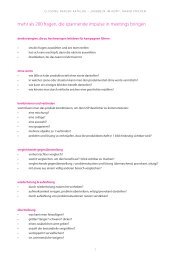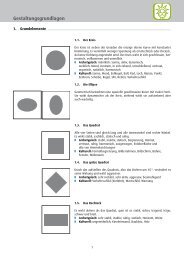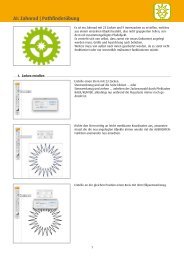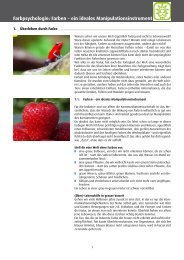Color Concepts 3 - grafixerin.com
Color Concepts 3 - grafixerin.com
Color Concepts 3 - grafixerin.com
You also want an ePaper? Increase the reach of your titles
YUMPU automatically turns print PDFs into web optimized ePapers that Google loves.
PALM SIZE PRESS<br />
Two-<strong>Color</strong> printing<br />
Red can really pop off a page. Use it<br />
with caution as a second color (with<br />
black), though, since its tint is pink,<br />
which reads as a different hue. Green<br />
or blue are choices that have more<br />
versatility as a second color due to<br />
their more harmonious tints. If you<br />
are using photographs, investigate<br />
second colors that would make a<br />
good duotone halftone, such as a<br />
grayish blue, to really give your<br />
pictures some elegance and depth.<br />
how to be smart<br />
M<br />
FLOWERS<br />
Red as a second color can<br />
really be striking<br />
Green or blue work well when<br />
you use halftones or duotones<br />
Memory colors<br />
We all have a set of notions about<br />
what certain colors mean or evoke.<br />
<strong>Color</strong> is subjective, but everyone<br />
thinks of a certain color if we say<br />
“fire engine” or “banana.” Keep this<br />
in mind when designing with color<br />
—a catalog of fine leather luggage<br />
would probably not call for sunset<br />
reds and lime greens, and a brochure<br />
for a Hawaiian vacation would not<br />
use muted tones of burgundy and<br />
hunter green.<br />
COLOR<br />
CONCEPTS3<br />
Using <strong>Color</strong> in Design<br />
<strong>Color</strong>s can be the first thing<br />
someone sees in your design, before<br />
they inspect the typography or read<br />
the text. Your choices can greatly<br />
affect the tone and message of<br />
your piece.<br />
Warm and cool<br />
We might be tempted to think of<br />
experience-based temperature as it<br />
applies to color: Fire is hot or warm<br />
(red, orange); water or ice is cool<br />
(blue, white). However, since fire can<br />
be white and water can also be<br />
boiling hot, this analogy is not<br />
perfect. The basic color wheel has<br />
more “warm” colors than “cool”<br />
ones, but the relative warmth of a<br />
color depends on the colors and the<br />
light in its proximity.<br />
Complement vs. contrast<br />
If you are using several colors in<br />
your design, take note of their<br />
relationship on a color wheel.<br />
Analogous colors (next to each other<br />
on the wheel) might support each<br />
other better in a piece that needs<br />
harmony. A pair of <strong>com</strong>plements can<br />
also be a good choice to liven up a<br />
design—they will have a natural<br />
balance, because every <strong>com</strong>plementary<br />
pair contains the three<br />
primaries. In either case, it is a good<br />
idea not to mix colors of vastly<br />
different saturation, but useful to<br />
contrast colors of different value<br />
for zest.<br />
Economy of color<br />
Whatever your design, using less<br />
color than more is usually a good<br />
idea. Too many colors can distract<br />
from your message by forcing your<br />
readers to sort through each color’s<br />
memory associations, as well as the<br />
various color relationships created.<br />
Chaotic use of color<br />
Still colorful, but less noisy<br />
All of these blues can seem cool when near warmer<br />
colors such as red. When together as above, the blue<br />
on the left appears coolest<br />
Palm-Size Press presents<br />
a series of guides to the<br />
basics of typography,<br />
color, and document<br />
design. Offered as PDF<br />
files on Adobe’s Web site,<br />
these print-it-yourself<br />
booklets <strong>com</strong>e with easy<br />
folding instructions.<br />
Collect them all for a little<br />
library of tiny tips!<br />
Inappropriate color choice<br />
A better alignment of color and subject<br />
Complementary<br />
Analogous<br />
NEWSLETTER<br />
our <strong>com</strong>munity voice<br />
NEWSLETTER<br />
our <strong>com</strong>munity voice<br />
© 1998<br />
Adobe Systems<br />
Incorporated<br />
www.adobe.<strong>com</strong><br />
Though leaves may<br />
vary in color in<br />
nature, a stylized<br />
leaf “reads” better<br />
with green<br />
Using <strong>Color</strong> Effectively
Palm Size Press: Folding Instructions<br />
You can print out the second page of this PDF file and fold and cut according<br />
to the following instructions—then you'll have another addition to your<br />
little library of tips!<br />
1. Start with the 8.5x11<br />
piece of paper you<br />
printed out.<br />
2. Fold in half shortwise,<br />
printed side out.<br />
3. Fold back one edge<br />
to the middle fold.<br />
4. Fold back the other<br />
edge to the middle fold.<br />
5. After unfolding the sheet,<br />
fold longwise, printed side out.<br />
6. Refold shortwise, then use<br />
scissors to cut along the line<br />
marked here in bold.<br />
cut along this line,<br />
but through the two layers<br />
of the folded paper<br />
7. Holding each end, push to<br />
the middle to open up where<br />
you made the cut.<br />
8. Push all the way in.<br />
9. Fold the left edge over to<br />
create the cover. Now it is a book!






